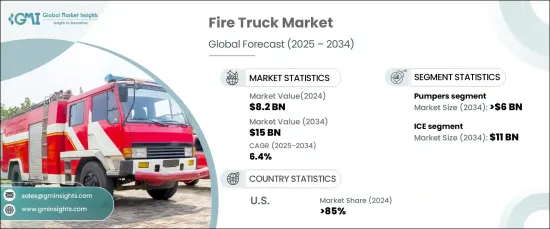
세계 소방차 시장은 2024년 82억 달러로 평가되었고, 2025-2034년 연평균 6.4% 성장할 것으로 예상됩니다.
이러한 성장은 위험물 사고, 산업 화재, 도시 응급 상황 등 비상 상황이 복잡해지고 화재 관련 사망자 수가 증가함에 따라 소방서들은 전례 없는 수요에 직면해 있습니다. 소방서는 전례 없는 수요에 직면하고 있으며, 다양한 비상 상황에 대응할 수 있는 고도의 다기능 소방차가 요구되고 있습니다. 그 결과, 소방차는 신속한 재구성이 가능한 모듈식 설계를 통해 다양한 상황에 대응할 수 있는 다용도 긴급 대응 플랫폼으로 진화하고 있습니다. 시장의 미래는 텔레매틱스, IoT 시스템, 첨단 파워트레인과 같은 기술 혁신에 의해 주도되고 있으며, 이 모든 것이 차량의 효율성, 신뢰성 및 전반적인 운영 효율성을 향상시키고 있습니다.

차량 유형에 따라 소방차 시장은 펌프차, 공중사다리차, 유조선, 구조차, 항공기 구조 및 소방(ARFF) 트럭, 산업용 트럭, 특수 트럭으로 나뉩니다. 시장을 독점하고 있는 것은 펌프 트럭으로 2024년 전체 시장 점유율의 40% 이상을 차지할 것으로 예상됩니다. 이 부문은 2034년까지 60억 달러의 수익을 창출할 것으로 예상됩니다. 최신 펌프 트럭은 알루미늄, 탄소섬유, 고강도 복합재와 같은 경량 소재를 사용하여 제조되고 있습니다. 이를 통해 적재량과 연비를 향상시키면서 무게를 줄일 수 있습니다. 또한, 컴퓨터 지원 설계 및 유한 요소 분석을 포함한 첨단 엔지니어링 기술을 사용하여 차량의 전체 중량을 최소화하면서 구조적 무결성을 보장합니다.
| 시장 범위 | |
|---|---|
| 시작 연도 | 2024년 |
| 예측 연도 | 2025-2034년 |
| 시작 금액 | 82억 달러 |
| 예상 금액 | 150억 달러 |
| CAGR | 6.4% |
파워트레인 부문은 내연기관(ICE), 전기, 하이브리드 부문으로 나뉘며, ICE 부문은 2034년까지 110억 달러의 수익을 창출할 것으로 예상됩니다. 소방차 제조업체들은 다양한 지형에 대한 차량의 적응성을 향상시키기 위해 내연기관 플랫폼을 강화하고 있습니다. 이는 도시, 농촌, 황야에서 발생하는 긴급 상황에서 트럭이 효과적으로 작동할 수 있도록 하는 데 매우 중요합니다. 내연기관 트럭의 기술 혁신에는 첨단 트랙션 제어 시스템, 특수 서스펜션, 적응형 사륜구동 시스템, 가혹한 조건에서도 작동하도록 설계된 강력한 냉각 장치 등이 포함됩니다. 또한, 계산 모델링을 통해 파워트레인을 최적화하여 다양한 환경에서의 신뢰성을 보장합니다.
미국에서는 소방차 시장이 2024년 85%의 압도적인 점유율을 차지했습니다. 미국 소방서는 첨단 텔레매틱스 및 사물인터넷(IoT) 시스템과 같은 첨단 기술을 도입하고 있습니다. 이러한 기술은 실시간 진단, 성능 모니터링, 예지보전 기능을 제공하여 차량 다운타임을 줄이고 차량 관리를 최적화하는 데 도움이 됩니다. 트럭에 통합된 센서가 엔진의 건전성과 장비의 상태를 모니터링하고 머신러닝 알고리즘이 잠재적인 기계 고장을 예측하여 더 높은 수준의 즉각적인 대응력을 보장하고 소방차의 수명을 연장합니다. 이러한 기술의 지속적인 발전은 보다 효율적이고 신속하며 신뢰할 수 있는 소방 서비스에 대한 수요 증가를 반영하고 있습니다.
The Global Fire Truck Market was valued at USD 8.2 billion in 2024 and is expected to grow at a CAGR of 6.4% from 2025 to 2034. This growth can be attributed to the rising complexity of emergencies, including hazardous material incidents, industrial fires, and urban emergencies, as well as an increasing number of fire-related fatalities. Fire departments are facing unprecedented demands, requiring highly advanced, multifunctional fire trucks that are equipped to handle a wide array of emergencies. As a result, fire trucks are evolving into versatile emergency response platforms with modular designs that allow for rapid reconfiguration, ensuring they can address diverse situations. The market's future is driven by technological innovations such as telematics, IoT systems, and advanced powertrains, all of which enhance vehicle efficiency, reliability, and overall operational effectiveness.

In terms of vehicle types, the fire truck market is divided into pumpers, aerial ladder trucks, tankers, rescue trucks, aircraft rescue and firefighting (ARFF) trucks, industrial trucks, and specialty trucks. The pumper trucks dominate the market, accounting for over 40% of the total market share in 2024. This segment is forecasted to generate USD 6 billion in revenue through 2034. Modern pumpers are built using lightweight materials like aluminum, carbon fiber, and high-strength composites. This reduces weight while boosting payload capacity and fuel efficiency. Additionally, advanced engineering technologies, including computer-aided design and finite element analysis, are being employed to ensure structural integrity while minimizing the overall weight of these vehicles.
| Market Scope | |
|---|---|
| Start Year | 2024 |
| Forecast Year | 2025-2034 |
| Start Value | $8.2 Billion |
| Forecast Value | $15 Billion |
| CAGR | 6.4% |
When it comes to powertrains, the market is divided into internal combustion engine (ICE), electric, and hybrid categories. The ICE segment is projected to generate USD 11 billion in revenue by 2034. Fire truck manufacturers are enhancing internal combustion platforms to improve the vehicles' adaptability to various terrains. This is crucial for ensuring the trucks perform effectively during emergency situations in urban, rural, and wilderness settings. Innovations in ICE-powered trucks include advanced traction control systems, specialized suspensions, adaptive all-wheel-drive systems, and robust cooling mechanisms designed to perform under extreme conditions. Moreover, computational modeling is being used to optimize powertrains, guaranteeing their dependability in diverse environments.
In the United States, the fire truck market held a dominant 85% share in 2024. U.S. fire departments are increasingly adopting state-of-the-art technologies like advanced telematics and Internet of Things (IoT) systems. These technologies provide real-time diagnostics, performance monitoring, and predictive maintenance features that help reduce vehicle downtime and optimize fleet management. Sensors integrated into the trucks monitor engine health and equipment status, while machine learning algorithms predict potential mechanical failures, ensuring a higher level of readiness and extending the life of fire trucks. The continuous advancement of these technologies reflects the growing need for more efficient, responsive, and reliable fire services.